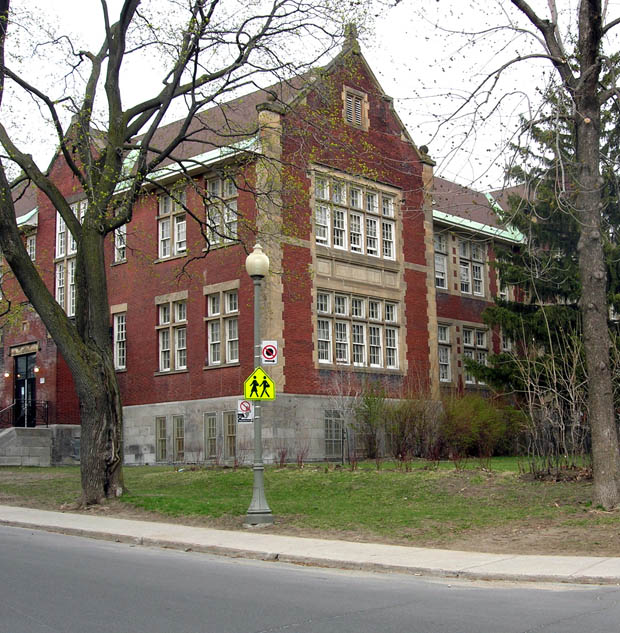![]() |
Pablo Palacios, seen after coming in second
in the police union presidential vote of 1994 |
Montreal, like so many other cities in the early 1990s, was hit with an epidemic that turned once-promising young women into glassy-eyed wanderers, standing on street corners ready to do anything for a fix; formerly-reliable young men lost interest in everything except sucking a pipe and others were lured into quick-buck crime only to get gunned down in street posse gunplay.
Officer Pablo Palacios, then in his mid-30s, didn't look or sound like your typical cop, as he was physically unimposing, sported wispy hair, sported wire-rimmed glasses and spoke softly with a slight Castillian lilt.
Unlike his colleagues, who spent shifts looking clockwatching and re-upping their doughnut supply, Palacios found himself deeply troubled by the sight of jittery young men walking to BMWs, fixing their place in the supply chain that sucked life from the poor and turning brutish drug dealers into role models for every kid in the area.
Repeated shakedowns hardly made a dent, so Palacios sought another route to taking down the crack trade.
Kirt “Easy” Haywood was a mirror reflection of Palacios, an ambitious immigrant with trouble fitting into his crew.
Raised in the crime-infested hills near Port of Spain, Trinidad, Haywood - a pragmatist who considered crime a legitimate business - was never fully accepted into his Cote des Neiges drug posse.
Known for his signature dreads that fell halfway down his slim six-foot frame, Haywood’s indifference to cars, flashy clothing and guns kept him out of the inner circle of his crew, the Gilligan Posse, right up until the day it dissolved after its leader was murdered.
But the frustrations Palacios and Haywood shared would disappear when they forged a secret relationship from opposite sides of the drug war. Their deal would, for a while, fulfill each other’s wildest professional ambitious before spiraling off into death and disaster.
When Palacios arrived in Little Burgundy, he was a veteran desk jockey from Wiretaps with only a couple of years of cruising sleepy west island bedroom communities.
The area he was sent to police, down the hill from the old Forum, was once the turf of the cold-blooded Dubois clan. But by the 90s it had become a squalid, low-income zone where young blacks would drop their games of hoops to flock to the wad-wielding Beemer drivers cruising by.
Sometimes cops would frisk the "baseball playas" and find thousands of dollars of uncashed welfare cheques amongst the big wads.
But in most cases local cops, sensitive to the colour and language gap, were apprehensive to spark the black rage that was all the fashion of the early 80s, already heightened by their inexplicable shooting a young black man named Anthony Griffin.
Kirt Haywood set up shop in the neighbourhood from a terminally messy apartment in the housing projects at 865 St. Martin where he’d stay up all night processing the baking powder and cocaine to make the precious rocks, while endlessly watching Kung Fu movies and selling to baseheads.
Haywood was disciplined enough to get high only during his periodic parties with hookers at motels on St. Jacques street but his wife’s love of the pipe would bounce her in and out of rehab and cost her custody of their four children. Even Haywood’s sickly, elderly, mother, who lived with them, was nabbed for drug possession.
Palacios, while still a neophyte to the ways of bringing in drug dealers, was told to stand back and watch one night as his squad moved into bust Haywood’s set up. As the cops flipped sofa cushions and ran their hands behind his laminated pictures, Haywood stood in his backyard, boasting that he was too smart for the cops and promised them they’d emerge empty-handed.
He was right. But as the police departed, Palacios spoke to Haywood for the first time. “I wasn’t here before,” Palacios told Haywood.
“But I’m here now.”
With that, the seeds were planted for a relationship that would help their separate ambitions blossom, before it all turned bad.
Later that evening Palacios returned to watch the comings and goings at Haywood’s home and eventually spotted a nervous-looking guy leave.
Teddy F., a thirtysomething shmatte executive at dadco, was also on the pipe.
He had run out of cash and had already paid Haywood for drugs with his Ninja 900 motorcycle and a car. With a few well-chosen words, Palacios turned Teddy informant. And soon Palacios knew many of Haywood’s secrets, including where he hid his stash.
Armed with his newly-gained knowledge, Palacios confronted Haywood. But rather than bringing out the handcuffs, Palacios offered Haywod informal immunity in return for inside information on the other gates (crack dens) in the drug plagued area.
The rules were simple: as long as Haywood did not hit the street with guns or drugs, he’d be off limits for cops. Haywood saw an opportunity to wipe out his rivals and increase his profits.
He showed his good faith by fingering a local hood named Trees for the recent attempted murder of a rounder nicknamed Spliffy.
Spliffy survived the shooting but suffered a semi-paralysis to the face. He now lives in Ottawa and talks with a prosthetic device in his neck. Trees was convicted thanks to Haywood's tip.
Crack dealers, once carefree, were soon finding their operations easy pickings for Palacios and his team, whose constant and timely visits earned them a fast reputation as a force to fear.
While many locals cheered Palacios on quietly as he rounded up one crack dealer after another, others bitterly complained as their sons and brothers were thrown in jail: young, black, unskilled Montreal anglos deprived of a rare – perhaps only real chance – at wealth.
Haywood soon realized that what was bad for other cocaine dealers was good for him. He found himself inheriting customers from the defunct operations he had helped take down.
Demand increased and profits ballooned, yet Haywood kept spending his every nickel.
As time passed, a chorus of whispers grew, all speculating on why Haywood's operations appeared immune to police prosecution.
When Haywood sought to replenish his ever-increasing demand for cocaine from his Caribbean connection, he was hit by the brutal awakening: his suppliers had heard the rumours and cut off his supply.
Suddenly, Haywood, the biggest drug dealer in Montreal’s hottest crack area, had no product and no cash to buy product with.
All he had was desperate clients.
Haywood finally swung a drug deal meeting with a Colombian supplier named Juan Francisco Castillo in a laundry room in the basement in the dilapidated area of Park Extension on July 1.
Haywood failed to mention that he planned to pay for his purchase of eight ounces of pure cocaine with gunfire.
Haywood’s buddy Carol Richards shot the fleeing Colombian with a sawed-off shotgun, but Castillo was only glanced in the shoulder and leaped through a window, escaping on the 80 bus down Park Avenue.
From his hospital bed, the Colombian proved a reluctant witness, but police made a deal with the Colombian: tell us who shot you and we'll report that you were shot while trying to rob a jewelry store.
Castillo agreed and fingered Haywood as his shooter.
Police then launched a massive manhunt for Haywood, who found refugee in a motel on St. Jacques.
Police set up surveillance around Haywood's home and after hours of waiting, Haywood’s wife showed up in a car with several others inside. One man went into the home, returned and they all drove off
Seven police vehicles pulled that car over at 7:19 p.m. on July 3, 1991 at the corner of St. Antoine and McGill.
SWAT team chief Michel Tremblay approached the vehicle clad in a bullet-proof vest, helmet, and carrying a M-16 semi- automatic rifle.
Tremblay who only knew Haywood's likeness through a picture on a fax, believed that the man who had gone into the home was Haywood - even though he was seven inches too short and sported a clean-shaven dome.
Tremblay saw the man reach for something, which turned out to be a lighter. Tremblay panicked and squeezed his trigger, hitting him in the head.
Palacios, who arrived at the scene four minutes after the shot was fired, to see cops high-fiving each other while three shocked passengers sat among the remains of the man’s splattered brains and blood.
Palacios had to tell his colleagues that they’d shot the wrong man.
The victim, named Marcellus Francois, 24, died of his injuries July 18, leaving a three-year-old son and a widow pregnant with twins.
Haywood, by now terrified and holed up at Brossard’s Faucon Bleu motel, called Palacios and turned himself in.
Haywood was freed on bail on July 9, along with gunman Richards. Haywood kept up his hobby, providing helpful tips to police at the expense of other crack dealers, perhaps hoping his help would lighten his impending punishment.
Kirt Haywood was found dead near his girlfriend’s home in Pointe Claire on September 1. A Toronto-based contract killer was suspected of, but never charged, with the murder.
Before he was killed, Haywood had told Palacios of an armed drug dealer named Osmond Seymour Fletcher had been selling rock cocaine hidden inside his camera case around the basketball courts at Campbell Park.
Undercover cops confirmed the information and a team went in to arrest Fletcher, who took flight.
A police van gave chase and Palacios tackled and arrested Fletcher. But once in the station, Fletcher gave a false name and was mistakenly released.
Fletcher then phoned reporters, telling them that Kirt Haywood had been selling drugs for Palacios.
Police spotted Fletcher walking in Little Burgundy on November 14. Fletcher attempted to hail a passing cab but it sped off and a police officer wrestled him to the ground.
Fletcher, in pulling out his gun, accidentally shot himself in the head.
The city was abuzz with rumours that Fletcher would not have been reaching for his gun with his right hand, as he was left-handed. Three months later, the coroner ruled that Fletcher indeed shot himself in the scuffle.
But people on the street started whispering that Palacios killed Fletcher for being a snitch.
Palacios responded by inviting a CBC Montreal TV news crew to cover his beat on November 30, 1991.
The move backfired, as Palacios was shown knocking on Julia Alleyne's door, where several people were heard to be inside.
When asked who it was, Palacios answered "pizza man." Someone opened the door and Palacios entered, although he was not supposed to enter without a warrant.
Palacios later explained that he had arrest warrants for four drug dealers and suspected that they were in the apartment.
Palacios had already been targeted by two complaints in 1991. One mother claimed that Palacios had used excessive force against her when she objected to the arrest of her son.
Another complaint had it that Palacios had tried to bribe an informant with cocaine. He was cleared on both counts.
Palacios had become a polarizing figure, some started a petition supporting his war on drugs while others vilified him for his bold approach.
He was eventually transferred out and promoted to Lieutenant in 1994, coming in second that year in the vote for chief of the police brotherhood.
In 2008 black community leader Dan Philip described Palacios's legacy as being a “rogue cop, the most vicious animal the police ever produced.”
Palacios had more friction ahead. In a bizarre twist, several of his men – perhaps backed by the highest brass – had him tried for allegedly slapping the owner of a Crescent street bar.
Those officer testified against Palacios on charges of assault in 1997. Testifying in his own defense, Palacios gave as good as he got, describing the litany of misdeeds those very officers committed under his watch.
Palacios was acquitted and assigned to a desk job where he continues to this day.
Palacios and Haywood, two men so similar in their ways but so different in their goals, combined to shut down over three dozen crack dens.
The crack problem moved on and became manageable but it was not a war won without casualties.































